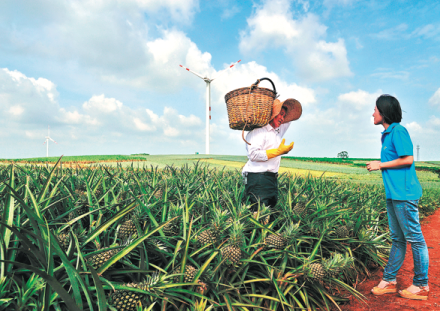Rural revitalization drive reports a bumper harvest
From being an unknown fishing village to a popular tourist attraction in South China's Guangdong province, Fangpo village in Zhanjiang city has accomplished the transition in just five years.
As a seaside resort located on the southernmost tip of China's mainland, the village not only boasts warm sunshine, soft beaches and coconut trees, but provides visitors with the best preserved coral reefs in China.
Fangpo is now a State-level natural reserve of coral reefs, having the largest area and most species of coral reefs in the epicontinental sea.
Ancient houses built with local corallite and other materials are another must-see in the village. Coral reef-themed bed-and-breakfasts have sprung up in recent years to help fuel local employment.
In addition to colorful reefs, Fangpo has rich sea-salt resources, with salt pans covering a total area of 136 hectares. Villagers have packed marine salt into souvenirs and developed the pans into a tourist attraction where visitors can experience salt production and taste high-quality sea salt.
The rural tourism industry has boosted the development of related sectors including catering and accommodation. At the same time it increased the incomes of local people.

A farmer in Zhanjiang's Xuwen county shows his pineapple plantation to a visitor. CHINA DAILY
In 2019, the per capita disposable income of Fangpo villagers reached 30,000 yuan ($4,640), up from 14,000 yuan in 2016.
In the same year, Fangpo was selected as a famous cultural and tourism village in Guangdong. It was listed among the top 10 most beautiful villages of the province in 2020.
The great changes that have taken place there can be mainly attributed to an overall rural revitalization strategy the Zhanjiang city government has applied over the past several years.
The strategy should follow rural development trends and make full use of each village's resources and industrial advantages, local officials said.
Over the past five years, Zhanjiang has established a slew of agricultural production bases with local characteristics. It also developed 21 demonstration sites for developing leisure agriculture and rural tourism.
Moreover, with a series of related projects carried out, living environments and basic infrastructure have been significantly improved in rural areas.
The projects included the construction of household trash and solid waste treatment plants, sanitary sewage treatment facilities and public toilets.
The city government has also promoted the separation of rain pipes from sewage lines, and the captive breeding of livestock and poultry.
Revitalizing rural areas is of key importance to Zhanjiang's poverty alleviation, the government said.
Last year, Zhanjiang urged the combination of rural revitalization by consolidating and expanding poverty alleviation outcomes. It held several meetings on targeted poverty alleviation with Foshan, another city in Guangdong, to create more cooperation opportunities. These include information sharing, personnel training and cooperation among companies, schools and villages in the two cities.
The initiative aims to prevent people in rural areas from falling back into poverty.
With years of anti-poverty efforts, Zhanjiang has raised the incomes of the poor. The per capita disposable income of its poorest people increased from 4,969 yuan in 2015 to nearly 15,000 yuan in 2020.
This year, which marks the beginning of the 14th Five-Year Plan (2021-25), Zhanjiang will promote the equalization of basic public services in rural areas, improve the level of electrification in villages to allow more rural residents cleaner energy options, harden road surfaces of 1,000 villages, accelerate the development of fiber-optic networks, and develop logistics and express delivery services in villages, according to the city government.



 Print
Print Mail
Mail